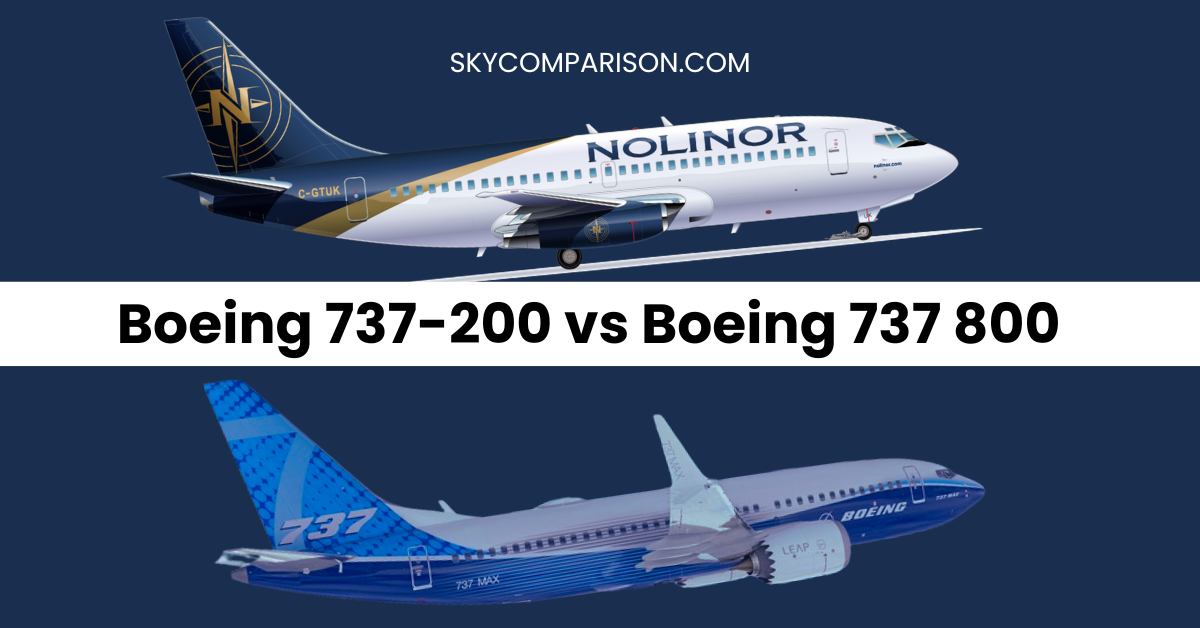The main difference between the Boeing 737-200 vs 737-800 boils down to their age and features. The 737-200 is an older model, known for its classic design and reliability during its time. On the other hand, the 737-800 is a newer version with updated technology and improved performance. It has a larger capacity, better fuel efficiency, and more modern amenities compared to the 737-200. So, while both planes share the same basic design, the 737-800 offers passengers a more comfortable and efficient flying experience.
BOEING 737-200 vs 737-800

The Boeing 737-200 vs 737-800 are two different versions of the popular Boeing 737 family. The 737-200, which has been around since 1969, is an older model compared to the 737-800. It’s a bit smaller, with a shorter length, wingspan, and height. The 737-200 has two engines with a thrust of 77 kN each, totaling 154 kN. It can carry around 115 passengers typically, with a maximum capacity of 136 passengers. In contrast, the 737-800 is larger and more modern, with a longer body and wingspan. It also has more powerful engines, with each producing 121 kN of thrust, totaling 242 kN. This allows it to carry around 162 passengers typically, with a maximum capacity of 189 passengers. Additionally, the 737-800 has a longer range and can fly farther distances compared to the 737-200. Overall, while both aircraft are part of the same family and serve similar purposes, the 737-800 offers more capacity, range, and modern features compared to the older 737-200. Check out our comparison of the Airbus A380 vs Boeing 737 to see how they differ.
Here’s a complete comparison table between the Boeing 737-200 vs 737-800:
| Characteristic | Boeing 737-200 | Boeing 737-800 |
|---|---|---|
| Length | 30.53 m (100 ft 2 in) | 39.50 m (129 ft 7 in) |
| Wingspan | 28.35 m (93 ft) | 35.80 m (117 ft 5 in) |
| Wing Area | 91.10 m² (981 ft²) | 125.00 m² (1,345 ft²) |
| Height | 11.29 m (37 ft) | 12.50 m (41 ft) |
| Engines | 2 | 2 |
| Thrust per Engine | 77 kN (17,400 lbf) | 121 kN (27,300 lbf) |
| Total Thrust | 154 kN (34,800 lbf) | 242 kN (54,600 lbf) |
| Maximum Takeoff Weight | 58,740 kg (129,000 lbs) | 79,000 kg (174,000 lbs) |
| Range | 4,200 km (2,268 nm) | 5,425 km (2,930 nm) |
| Cruise Speed | Mach 0.73 | Mach 0.785 |
| Capacity (typical) | 115 passengers | 162 passengers |
| Maximum Capacity | 136 passengers | 189 passengers |
| Body | Narrow | Narrow |
| Wing | Fixed Wing | Fixed Wing |
| Wing Position | Low wing | Low wing |
| Tail | Regular tail, mid set | Regular tail, mid set |
| WTC | M | M |
| APC | C | C |
| Type Code | L2J | L2J |
| Aerodrome Reference Code | – | 4C |
| RFF Category | 6 | 7 |
| Engine Position | Underwing mounted | Underwing mounted |
| Landing Gear | Tricycle retractable | Tricycle retractable |
| Manufactured as | BOEING CT-43, BOEING VC-96, | BOEING BBJ2, BOEING 737-800 BBJ2 |
| BOEING Surveiller, | BOEING 737-800, B738 | |
| BOEING 737-200, | ||
| BOEING 737-200 Surveiller, B732 |
Boeing 737-200 vs 737-800 Main Differences
Here are the differences between the Boeing 737-200 vs 737-800 with added data:
- Age: The Boeing 737-200, introduced in the 1960s, has been in service for over 50 years, while the 737-800, launched in the late 1990s, has been flying for around 25 years.
- Size: The Boeing 737-800 is larger than the Boeing 737-200, with a length of approximately 39.50 meters and a wingspan of 34.32 meters, compared to the 737-200’s length of approximately 30.50 meters and a wingspan of 28.35 meters.
- Engines: The 737-200 typically uses Pratt & Whitney JT8D engines, while the 737-800 is powered by CFM56-7B engines, which provide better fuel efficiency. The JT8D engines have dimensions of about 2.1 meters in diameter and 4.1 meters in length, whereas the CFM56-7B engines have dimensions of approximately 2.4 meters in diameter and 2.9 meters in length.
- Fuel Efficiency: The 737-800 is more fuel-efficient than the 737-200 due to its newer engines and design. It has a maximum takeoff weight (MTOW) of around 79,015 kilograms, compared to the 737-200’s MTOW of approximately 56,900 kilograms.
- Avionics: The 737-800 features more advanced avionics and cockpit technology compared to the 737-200, enhancing safety and navigation capabilities.
- Range: With its improved fuel efficiency and larger fuel capacity, the 737-800 has a longer range than the 737-200. The 737-800 can typically fly up to 3,115 nautical miles, while the 737-200 has a range of around 2,900 nautical miles.
- Cabin Interior: The cabin of the 737-800 is more modern and spacious than the 737-200, with improved amenities for passenger comfort. The 737-800 typically accommodates around 162 to 189 passengers in a standard two-class layout, while the 737-200 has a seating capacity of approximately 100 to 130 passengers.
- Performance: The 737-800 has superior performance characteristics compared to the 737-200, including higher cruise speeds, faster climb rates, and shorter takeoff and landing distances.
- Operational Costs: Overall, the 737-800 offers lower operating costs per seat mile compared to the 737-200, making it a more economical choice for airlines in terms of fuel consumption, maintenance, and efficiency.
Boeing 737-200

The Boeing 737-200 is an airplane made by Boeing. It’s a smaller airplane designed for short flights. It first started flying in 1969 and was one of the first models in the Boeing 737 family. The Boeing 737-200 is an important part of aviation history. It’s a smaller plane with fixed wings that fly low. It has two engines, usually made by Pratt & Whitney, which help it work well in different situations. The plane is about 28 meters wide and 30 meters long, giving passengers plenty of room inside. Even though they stopped making it in 1988, the 737-200 is still used in both commercial and military flights. It’s been changed over the years to do different jobs, like surveillance. People who love planes still like to see and fly in the 737-200 because it reminds them of how Boeing helped shape air travel.

Boeing 737-800

The Boeing 737-800, a member of the renowned Boeing 737 family, stands as a stalwart in commercial aviation. Characterized by its narrow body, low-wing design, and regular mid-set tail, the 737-800 epitomizes reliability and efficiency in air travel. With a wingspan of 34.32 meters, length of 39.50 meters, and height of 12.60 meters, this aircraft boasts impressive dimensions, providing ample space for passengers and cargo. Its power is derived from two CFM56-7B turbofans, each capable of generating 117 kN of thrust, facilitating a smooth take-off at 145 knots and a climb rate of 3000 ft/min up to 5000 feet. Cruising at a speed of 460 knots with a service ceiling of 41,000 feet, the 737-800 ensures swift and comfortable journeys, covering distances of up to 2000 nautical miles.

Boeing 737-200 vs 737-800 Engines
The main difference between the engines of the Boeing 737-200 and the 737-800 is like comparing an old car to a new one. The 737-200 typically used older Pratt & Whitney JT8D engines, which were reliable but not very fuel-efficient. These engines had dimensions of approximately 2.1 meters (7 feet) in diameter and 4.1 meters (13.5 feet) in length. On the other hand, the 737-800 is powered by newer CFM56-7B engines, which are more modern and use less fuel. These engines are slightly larger, with dimensions of about 2.4 meters (8 feet) in diameter and 2.9 meters (9.5 feet) in length. This means that the 737-800 can fly longer distances while using less fuel compared to the older 737-200. So, while both planes can get you where you need to go, the 737-800’s engines give it an advantage in terms of efficiency and performance.
Boeing 737-200 vs 737-800 Fuel
When it comes to fuel, the main difference between the Boeing 737-200 and the 737-800 is quite significant. The 737-200, being an older model, typically requires more fuel to cover the same distance compared to the 737-800. This is because the engines on the 737-200 are older and less fuel-efficient. On the other hand, the 737-800 boasts newer, more efficient engines, which means it can fly longer distances while using less fuel. So, while both planes can take you where you need to go, the 737-800’s improved fuel efficiency gives it an edge over the older 737-200 when it comes to operating costs and environmental impact.
Conclusion
In the showdown between the Boeing 737-200 vs 737-800, it’s clear that both planes have their strengths. The 737-200, with its classic design, served admirably in its time, while the 737-800 brings modern features and enhanced performance to the table. However, when it comes down to it, the 737-800 emerges as the winner. With its updated technology, larger capacity, and better fuel efficiency, it’s the go-to choice for airlines today. So, while the 737-200 may hold a special place in aviation history, the 737-800 is the clear winner for travelers looking for a safer, more comfortable, and more efficient flying experience.
FaQs
What is the Boeing 737-800?
What are the key features of the Boeing 737-800?
How many passengers can the Boeing 737-800 accommodate?
What is the range of the Boeing 737-800?
What engines power the Boeing 737-800?
what are the main difference in Boeing 737-200 vs Boeing 737-800?
| Characteristic | Boeing 737-200 | Boeing 737-800 |
|---|---|---|
| Length | 30.53 m (100 ft 2 in) | 39.50 m (129 ft 7 in) |
| Wingspan | 28.35 m (93 ft) | 35.80 m (117 ft 5 in) |
| Wing Area | 91.10 m² (981 ft²) | 125.00 m² (1,345 ft²) |
| Height | 11.29 m (37 ft) | 12.50 m (41 ft) |
| Engines | 2 | 2 |
| Thrust per Engine | 77 kN (17,400 lbf) | 121 kN (27,300 lbf) |
| Total Thrust | 154 kN (34,800 lbf) | 242 kN (54,600 lbf) |
| Maximum Takeoff Weight | 58,740 kg (129,000 lbs) | 79,000 kg (174,000 lbs) |
| Range | 4,200 km (2,268 nm) | 5,425 km (2,930 nm) |
| Cruise Speed | Mach 0.73 | Mach 0.785 |
| Capacity (typical) | 115 passengers | 162 passengers |
| Maximum Capacity | 136 passengers | 189 passengers |
| Body | Narrow | Narrow |
| Wing | Fixed Wing | Fixed Wing |
| Wing Position | Low wing | Low wing |
| Tail | Regular tail, mid set | Regular tail, mid set |
| WTC | M | M |
| APC | C | C |
| Type Code | L2J | L2J |
| Aerodrome Reference Code | – | 4C |
| RFF Category | 6 | 7 |
| Engine Position | Underwing mounted | Underwing mounted |
| Landing Gear | Tricycle retractable | Tricycle retractable |
| Manufactured as | BOEING CT-43, BOEING VC-96, BOEING 737-200, BOEING 737-200 Surveiller, B732 | BOEING BBJ2, BOEING 737-800 BBJ2, BOEING Surveiller, BOEING 737-800, B738 |



